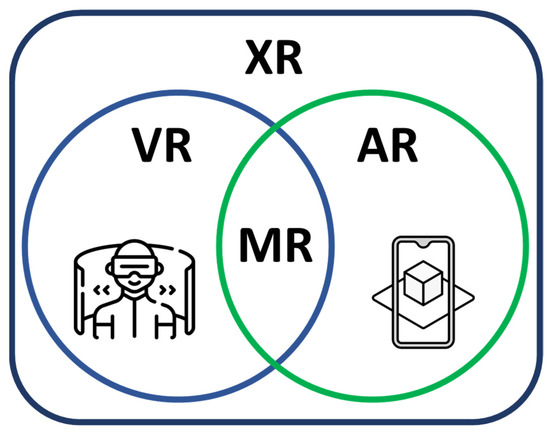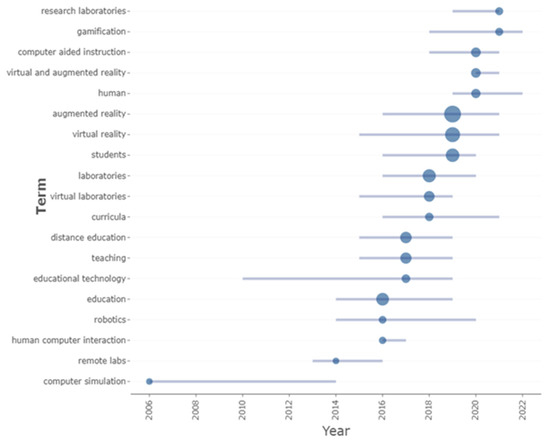You're using an outdated browser. Please upgrade to a modern browser for the best experience.
Please note this is a comparison between Version 1 by Enderson Pereira Júnior and Version 2 by Dean Liu.
Virtual reality or VR corresponds to a sensation, on the part of the user, of being physically present in a world that is not physical, through the use of images, sounds, and other stimuli created computationally for this purpose.
- augmented reality
- RADAR
- Education 4.0
1. Theoretical Background
In the pedagogical process, the constant search for the attention and interest of students leads teachers to introduce new methodologies and teaching technologies [1][16]. Between this and the development of information technology, traditional methods of education or training should be transformed into Education 4.0, which refers to digital teaching and learning [2][3][17,18]. Thus, augmented reality (AR) and virtual reality (VR) have been considered the main enabling technologies for Education 4.0 [4][19].
For this purpose, immersive technologies will be used, and the most used in the area of education, mainly in the teaching of complex disciplines, are virtual reality, augmented reality, and mixed reality [5][20]. When using these three technologies together, there is an expansion of the work, and it is called extended reality or cross-reality [6][21].
The elements of the cross-reality platform (i.e., virtual reality, augmented reality, and mixed reality) are an emerging image paradigm characterized by varying levels of immersion, interaction, and user presence [7][8][22,23]. Immersion refers to the feeling of physical existence within the extended reality environment, where a user is isolated from the real world [9][24]. Interaction is described as the ability to act and receive feedback within the digital environment. Presence is linked to the perception of the connection to the artificial environment, evoking the illusion of being present inside. Figure 1 express the meanings of these elements [10][25].

Figure 1. Perspective of XR, VR, MR, and AR.
Virtual reality or VR corresponds to a sensation, on the part of the user, of being physically present in a world that is not physical, through the use of images, sounds, and other stimuli created computationally for this purpose [11][26]. The use of VR devices, such as haptic gloves, for example, allows the user to feel the virtual world “on the skin” (literally) [12][13][27,28].
Augmented reality is a technology that, by allowing the user an immersive experience, without losing the perception of the real world, is increasingly arousing interest among researchers, namely for its applicability in various sectors [14][29]. This is a technology that overlaps a visual experience with a real environment and has as its main feature that it simply adds to theour experience of a real environment without actually interacting with it [15][30].
An AR system is composed of input, processing, and output modules. In the input module, the AR system performs the capture of the real scenario where the real objects will be inserted and the sensing by which this system identifies the objects, the user, and the user’s actions and positioning. The processing module is responsible for carrying out object monitoring (registering and tracking) [16][31], interaction management (identifies and determines the response to selection or manipulation actions of virtual objects), and application processing (promotes interactions and changes in the scenario). The output module is responsible for visualizing and rendering devices [17][32].
Mixed Reality (MR) refers to the interactivity between physical and virtual objects. Thus, MR is a mixture of physical and virtual worlds, although some believe that the term AR already includes the concept behind this term [18][33]. Mixed reality (MR) can be defined as the integration of computer-generated virtual systems with the physical environment, which is shown to the user with the support of some technological device in real time [19][34]. By mixing real-world and virtual scenes, MR goes beyond the ability of VR to realize the imaginary or reproduce the real. MR lies in the middle between completely virtual reality and physical reality as rweserachers know it. The goal of an MR system is to create an environment so realistic that one does not realize the difference between the virtual elements and the actual participants in the scene, treating them as one thing. When in mixed reality (MR), there are actions in the virtual world that have repercussions in the real world. There is also cross-reality (XR) [20][35].
Virtual reality laboratories require a structure that is often costly and impractical for most people, making them impossible to spread as a viable alternative to support distance education courses. Augmented reality (AR) is a more promising alternative in this sense.
2. Radar System
Radar (Radio Detection and Ranging) is electronic equipment used to determine the position, direction, shape, and speed of a moving object that was previously detected. Thus, it is an electromagnetic system to detect and provide information about the location of materials that reflect electromagnetic signals [21][36]. Conventional radar is widely used in the aeronautical industry to detect aircraft and space equipment, in the marine field to detect ships, and in the field of geography for selection and detection of the area and climate [22][37].
A Radar system uses electromagnetic radiation to detect objects that are in its range of action. Thus, the radar system that will be used in this work is based on radio detection by the reflection of energy by objects [23][38]. In this sense, because radar performs its basic functions, the object investigated should reflect the energy incident on it, and this reflected energy be captured by a reception system [24][39].
The operation of the radar system can be introduced synthetically as follows: a dis-positive transmitter emits, through an antenna, an electromagnetic (directional) wave through space. This transmitted wave is intercepted by an investigated object capable of reflecting its energy in many directions [25][40]. Part of this reflected energy, also called echo, is captured by the radar’s receiving antenna. This reflected signal is processed on the receiving device and is then sent to a display device with the exact position of the target [26][41].
Radars are classified either by the waveforms they use or by their operating frequency. By means of waveforms, electromagnetic wave transmission can be classified into two groups: Continuous Wave Form (CW) and Pulsed Wave Form [27][42]. Thus, Continuous-Wave Radar emits Radio Frequency (RF) energy continuously over time, while Pulsed Radar emits a train of rectangular pulses at a periodic repetition rate (T), and these pulses modulate the carrier of RF, as expressed in Figure 2.

Figure 2. Classification of Radar Types.
In addition to conventional radar systems, there are image radar systems, and the technologies most used in this type of radar system are Synthetic Aperture Radar (SAR) and Doppler Beam Sharpening (DBS) [28][43]. SAR is an important active microwave image sensor. Its ability to work all day and in any weather makes it play an important role in the remote sensory community [29][44]. Doppler Beam Sharpening (DBS) technology is widely used in applications such as helicopter rescue surveillance and early warning systems, and this technique works with a scanning antenna and stitches together segmented microwave images, which are obtained with high cross-gap resolution using windowed fast Fourier transform (FFT) at each beam position [30][45].
In summary, these complex techniques involving concepts of physics applied to radar systems could be taught through the new immersive technologies applied in Education 4.0, mainly augmented reality.
3. Bibliometric Analysis
BTo confirm the importance of this study, bibliometric research was carried out using Scopus as a database, limited to the period from 2000 to 2022, to elucidate the importance of the theme in question [31][32][46,47]. The topics were: virtual radar, virtual laboratory, and augmented reality. Bibliometrix rendered in the R computing language is used as support software. This study presents a total of 222 articles published in scientific articles, books, etc. As shown in Figure 3, this theme has high relevance, offers favorable volumes of annual publications, and presents a high level of interest and relevance on the part of the academic community.

Figure 3. The main publication channels per year.
The three main publication channels were Lecture Notes in Computer Science, Coeur Workshop Proceedings, and IEEE Global Engineering Education Conference, totaling 19 documents.
Finally, the main research themes related to the theme are observed, revealing the period of each year that determines the concentration of these specific applications in various criteria. These terms suggest important areas of research in which to focus research efforts in health systems. Figure 4 shows some data.

Figure 4. The main research themes related to the theme are observed.
